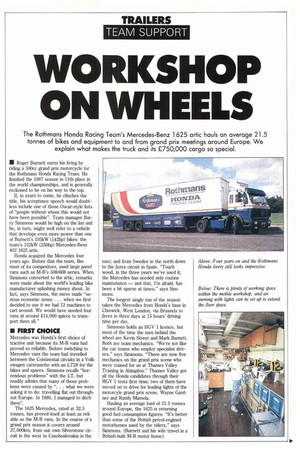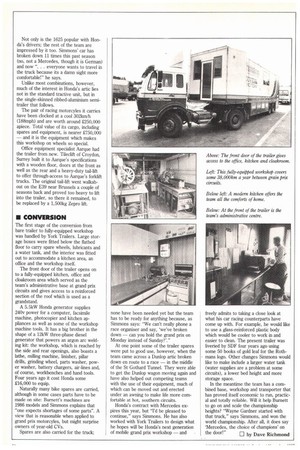WORKSHOP ON WHEELS
Page 57

Page 58

If you've noticed an error in this article please click here to report it so we can fix it.
The Rothmans Honda Racing Team's Mercedes-Benz 1625 artic hauls an average 21.5 tonnes of bikes and equipment to and from grand prix meetings around Europe. We explain what makes the truck and its £750,000 cargo so special.
• Roger Burnett earns his living by riding a 500cc grand prix motorcycle for the Rothmans Honda Racing Team. He finished the 1987 season in 11th place in the world championships, and is generally reckoned to be on his way to the top.
If, in years to come, he clinches the title, his acceptance speech would doubtless include one of those Oscar-style lists of "people without whom this would not have been possible". Team manager Barry Simmons would be high on the list and he, in turn, might well refer to a vehicle that develops even more power than one of Burnett's 105kW (142hp) bikes: the team's 152kW (250hp) Mercedes-Benz 402 1625 artic.
Honda acquired the Mercedes four years ago. Before that the team, like most of its competitors, used large panel vans such as M-B's 508/608 series. When Simmons converted to the artic, remarks were made about the world's leading bike manufacturer splashing money about. In fact, says Simmons, the move made "serious economic sense. . . when we first decided to use it we had 12 machines to cart around. We would have needed four vans at around £14,000 apiece to transport them all."
• FIRST CHOICE •
Mercedes was Honda's first choice of tractive unit because its M-B vans had proved so reliable. Before switching to Mercedes vans the team had travelled between the Continental circuits in a Volkswagen caravanette with an LT28 for the bikes and spares. Simmons recalls "horrendous problems" with the LT, but readily admits that many of those problems were caused by ". . what we were asking it to do: travelling fiat out throughout Europe. In 1980, I managed to ditch them".
The 1625 Mercedes, rated at 32.5 tonnes, has proved itself at least as reliable as the M-B vans. In the course of a grand prix season it covers around 37,000km, from our own Silverstone circuit in the west to Czechoslovakia in the east; and from Sweden in the north down to the Jerez circuit in Spain. "Touch wood, in the three years we've used it, the Mercedes has needed only routine maintenance — and that, I'm afraid, has been a bit sparse at times," says Simmons.
The longest single run of the season takes the Mercedes from Honda's base in Chiswick, West London, via Brussels to Jerez in three days at 15 hours' driving time per day.
Simmons holds an HGV 1 licence, but most of the time the men behind the wheel are Kevin Street and Mark Barnett. Both are team mechanics. "We're not like the car teams who employ specialist drivers," says Simmons. "There are now five mechanics on the grand prix scene who were trained for us at Thames Valley Training in Abingdon." Thames Valley got all the Honda candidates through their HGV 1 tests first time; two of them have moved on to drive for leading lights of the motorcyle grand prix scene, Wayne Gardner and Randy Mamola.
Hauling an average load of 21.5 tonnes around Europe, the 1625 is returning good fuel consumption figures: "It's better than some of the British petrol-engined motorhomes used by the riders," says Simmons. (Burnett and his wife travel in a British-built M-B motor home). Not only is the 1625 popular with Honda's drivers; the rest of the team are impressed by it too. Simmons' car has broken down 11 times this past season (no, not a Mercedes, though it is German) and now ". . everyone wants to travel in the truck because its a damn sight more comfortable!" he says.
Unlike most combinations, however, much of the interest in Honda's artic lies not in the standard tractive unit, but in the single-skinned ribbed-aluminium semitrailer that follows.
The pair of racing motorcyles it carries have been clocked at a cool 302km/h (188mph) and are worth around 2250,000 apiece. Total value of its cargo, including spares and equipment, is nearer 2750,000 — and it is the equipment which makes this workshop on wheels so special.
Office equipment specialist Aarque had the trailer from new. Tiled& of Croydon, Surrey built it to Aarque's specifications with a wooden floor, doors at the front as well as the rear and a heavy-duty tail-lift to offer through-access to Aarque's forklift trucks. The original tail-lift went walkabout on the E39 near Brussels a couple of seasons back and proved too heavy to lift into the trailer, so there it remained, to be replaced by a 1,500kg 7,epro lift.
• CONVERSION
The first stage of the conversion from bare trailer to fully-equipped workshop was handled by York Trailers. Large storage boxes were fitted below the flatbed floor to carry spare wheels, lubricants and a water tank, and the interior was fitted out to accommodate a kitchen area, an office and the workshop itself.
The front door of the trailer opens on to a fully-equipped kitchen, office and cloakroom area which served as the team's administrative base at grand prix circuits and gives access to a reinforced section of the roof which is used as a grandstand.
A 5.5kW Honda generator supplies 240v power for a computer, facsimile machine, photocopier and kitchen appliances as well as some of the workshop machine tools. It has a big brother in the shape of a 12kW three-phase diesel generator that powers an argon arc welding kit: the workshop, which is reached by the side and rear openings, also boasts a lathe, milling machine, linisher, pillar drills, grinding wheel, parts washer, power washer, battery chargers, air-lines and, of course, workbenches and hand tools. Four years ago it cost Honda some .216,000 to equip.
Naturally many bike spares are carried, although in some cases parts have to be made on site: Burnett's machines are 1986 models and Simmons explains that "one expects shortages of some parts". A view that is reasonable when applied to grand prix motorcyles, but might surprise owners of year-old CVs.
Spares are also carried for the truck; none have been needed yet but the team has to be ready for anything because, as Simmons says: "We can't really phone a race organiser and say, 'we've broken down — can you hold the grand prix on Monday instead of Sunday?'."
At one point some of the trailer spares were put to good use, however, when the team came across a Dunlop artic broken down en route to a race — in the middle of the St Gothard Tunnel. They were able to get the Dunlop wagon moving again and have also helped out competing teams with the use of their equipment, much of which can be moved out and erected under an awning to make life more comfortable at hot, southern circuits.
Honda's contract with Mercedes expires this year, but "I'd be pleased to continue," says Simmons. He has also worked with York Trailers to design what he hopes will be Honda's next generation of mobile grand prix workshop — and freely admits to taking a close look at what his car racing counterparts have come up with. For example, he would like to use a glass-reinforced plastic body which would be cooler to work in and easier to clean. The present trailer was liveried by SDF four years ago using some 50 books of gold leaf for the Rothmans logo. Other changes Simmons would like to make include a larger water tank (water supplies are a problem at some circuits), a lower bed height and more storage space.
In the meantime the team has a combined base, workshop and transporter that has proved itself economic to run, practical and totally reliable. Will it help Burnett to go on and scale the championship heights? "Wayne Gardner started with that truck," says Simmons, and won the world championship. After all, it does say 'Mercedes, the choice of champions' on the door!" 0 by Dave Richmond




































































































